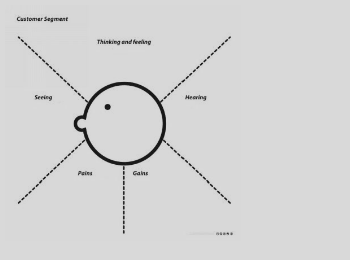Business Analyst
Empathy Map can be drawn in and shape and size but the main parts of an empathy map are:-
- Thinking
- Seeing
- Doing
- Feeling
Take an example of Customer Segment to understand the different parts of an empathy map.
Thinking and feeling – This section deals with getting in the shoes of the customer and to know what they really want, think and feel for the product. What are their hopes, dreams, and fears?
Hearing – It maps all the things which the customer hears from different sources e.g. Social Media, Print Media, Customer feedback, etc. Basically what influences the customer!
Seeing – It looks after what the customer looks at? Everything including her environment, friends, and what the market offers. Pains – The problems felt by the customer in order to purchase a product or receive a service from the company. It could be anything between the problem in logging in to the website to bad service from the company’s side.
Gain– Now the main part i.e. the customer’s expectation from the company and the product.

So this map helps you get all the required information about the customer and his views.
Thinking and feeling – This section deals with getting in the shoes of the customer and to know what they really want, think and feel for the product. What are their hopes, dreams, and fears?
Hearing – It maps all the things which the customer hears from different sources e.g. Social Media, Print Media, Customer feedback, etc. Basically what influences the customer!
Seeing – It looks after what the customer looks at? Everything including her environment, friends, and what the market offers. Pains – The problems felt by the customer in order to purchase a product or receive a service from the company. It could be anything between the problem in logging in to the website to bad service from the company’s side.
Gain– Now the main part i.e. the customer’s expectation from the company and the product.
So this map helps you get all the required information about the customer and his views.
Forecasting is the process of predicting the future of a product or company based on the performance in the past and present data.
Qualitative forecasting is subjective and it depends on the opinion of the customer. It is usually applied to the intermediate or long-range decisions. Quantitative forecasting depends on the past and present data to predict the future condition of the product. If there are no data available, or if the data available are not relevant to the forecasts, then qualitative methods must be used.
The 4 main forecasting techniques are:-
1) Delphi Technique – This technique involves questioning, compilation, and re-questioning until the company reaches a conclusion. The panel of experts are made to prepare some question and they are asked to answer these questions, the answers are then evaluated. After this, the questions are re asked to the panel. This process is carried on in an infinite loop until and unless a conclusion is reached.
2) Subjective approach – The subjective approach uses a lot of brainstorming approaches by the core members along with employees to generate ideas and solve problems of the company. This prediction is done based on subjective thoughts and feelings
3) Time Series Forecasting – It is a quantitative technique and it involves looking for trends in the business by crunching data on hourly, daily, weekly, monthly, yearly, or longer periods. The increase in cold drink sales in the festive season in India is an example of a seasonal event.
4) Scenario Writing - In Scenario Writing, the forecaster generates different outcomes based on different starting criteria. The decision-maker then decides on the most likely outcome from the numerous scenarios presented. Scenario writing typically yields the best, worst, and middle option.
1) Delphi Technique – This technique involves questioning, compilation, and re-questioning until the company reaches a conclusion. The panel of experts are made to prepare some question and they are asked to answer these questions, the answers are then evaluated. After this, the questions are re asked to the panel. This process is carried on in an infinite loop until and unless a conclusion is reached.
2) Subjective approach – The subjective approach uses a lot of brainstorming approaches by the core members along with employees to generate ideas and solve problems of the company. This prediction is done based on subjective thoughts and feelings
3) Time Series Forecasting – It is a quantitative technique and it involves looking for trends in the business by crunching data on hourly, daily, weekly, monthly, yearly, or longer periods. The increase in cold drink sales in the festive season in India is an example of a seasonal event.
4) Scenario Writing - In Scenario Writing, the forecaster generates different outcomes based on different starting criteria. The decision-maker then decides on the most likely outcome from the numerous scenarios presented. Scenario writing typically yields the best, worst, and middle option.
*/?>
*/?>
*/?>
*/?>